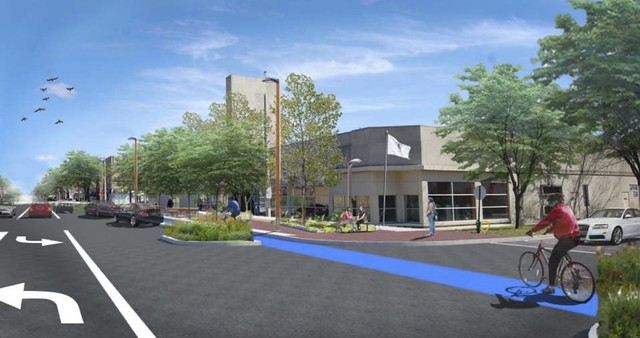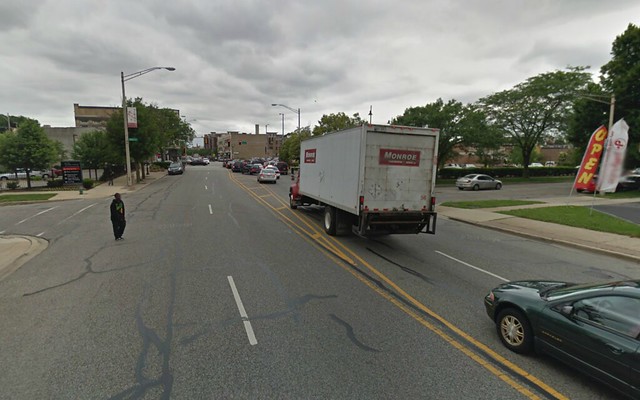Active Transportation Alliance director and Oak Park resident Ron Burke says he’s tired of waiting for the village’s trustees to move forward with making Madison a safer and more economically viable complete street. A plan was proposed nearly three years ago to reduce crashes and make the street more walkable and bikeable with a road diet on the street between Austin and Harlem. A survey at the time found the overwhelming majority of residents support the plan, Burke said.
The suburb has millions of dollars in tax increment financing, as well as a federal grant, that could be used for the project. However, no action has been taken since the plan came out, because the village board has been deliberating on whether to use TIF money for a new school district headquarters, Burke said. Now that decision is largely resolved, Active Trans recently launched a letter writing campaign to let Oak Park leaders know they shouldn’t further delay improvements to Madison, garnering over 200 signatures in a week.
Currently, this stretch of Madison is a wide, four-lane street with a limited number of left turn lanes and too much capacity for the 18,300 cars it carries on average each day. As a result, it’s got one of the highest crash rates in Chicagoland, with about 235 collisions per year. That's roughly twice the collision rate of Lake Shore Drive, which the Illinois Department of Transportation has said is one of the most crash-prone roads in the state.
The collisions on Madison are mostly car-on-car, but an average of seven pedestrians and cyclists are struck on this stretch per year. Active Trans recently included Madison/Harlem on its list of the 20 most dangerous intersections in the region. Tragically, 92-year-old Suleyman Cetin was fatally struck while biking across Madison at Scoville last year.
Furthermore, Madison serves as a major barrier to people on foot and bikes, discouraging travel between the north and south sides of Oak Park. The car-centric street layout and high speeds have also contributed to a lackluster retail picture on the street, with a high number of fast food restaurants and empty lots, Burke said.
As such, Madison is an ideal candidate for a “four-to-three” conversion, which would transform the street from four mixed traffic lanes to two travel lanes, turn lanes, and bike lanes. This kind of road diet has been implemented successfully on Chicago streets like South Chicago, 55th Street, Broadway, and Lawrence.
In addition to providing dedicated space for bikes, four-to-three conversions calm and organizes car traffic, shorten pedestrian crossing distances, and can provide space for wider sidewalks. The more people-friendly street, along with slower car speeds that make motorists more likely to notice storefronts, can be a shot in the arm for existing retail. It can also lead to more interest from new merchants and developers. For example, Chicago’s 47th Ward Alderman Ameya Pawar has credited the recent Lawrence road diet and streetscape project with attracting several new businesses.
Some Oak Parkers have been concerned that a road diet on Madison would lead to congestion and traffic being diverted onto side streets. However, four-to-three conversions generally work well on streets that carry less than 20,000 cars per day. Active Trans points out that traffic flows smoothly on Oak Park’s Ridgeland Avenue, a two-lane street which averages 18,000 cars a day and doesn’t even have turn lanes.
In early 2012, a study commissioned by the village of Oak Park [view a presentation on the study here] put forth three different scenarios for a road diet on Madison. The cost estimates ranged from $17 million to $6.9 million, depending on how complex, and how fancy, the infrastructure and street furniture would be. The Madison Street TIF had a balance of over $7 million as of last year, and the village also won a $575,000 federal grant to install bike lanes on the street.
The grandiose nature of some of the designs, including gateway arches, expensive lighting, nice pavers, and blue bike lanes, may have contributed to the delay in moving forward with the road diet, Burke said. “One of the challenges is that it’s perceived as a $17 million project when it could be done for much, much less.” He estimated that a four-to-three conversion that simply involved restriping the lanes and adding high-visibility crosswalks -- similar to what was done on Chicago’s Broadway between Wilson and Foster -- could be done for only about $1.5 million.
Burke said that, as a Oak Park homeowner, he’s frustrated with the village trustees’ failure to take action to reduce crashes on Madison. “The conversation needs to be less about this proposal or that one, but whether the board is going to tell city staff to use TIF dollars to make improvements to the street.”
The trustees are meeting at the village hall, 123 Madison Street, on Monday at 7:30. Burke expects that the issue of spending TIF funds on the school headquarters will be finalized then. With that decision out of the way, he hopes the Active Trans petition will prompt the leaders to finally move forward with a plan to transform Madison from a speedway to a livable street.






